The following images are from an original issue of Needlecraft magazine I own from February 1913. Enjoy the fashions and descriptions!
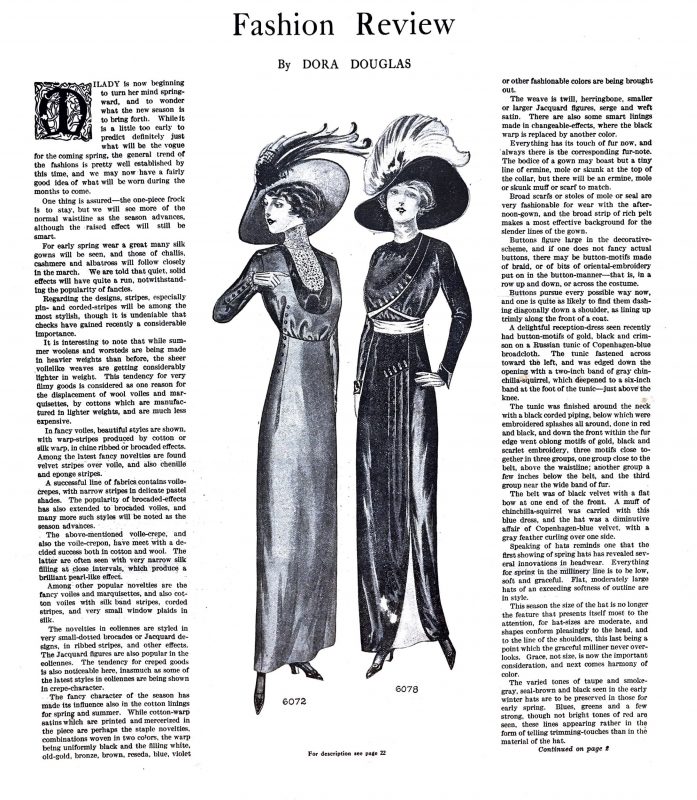
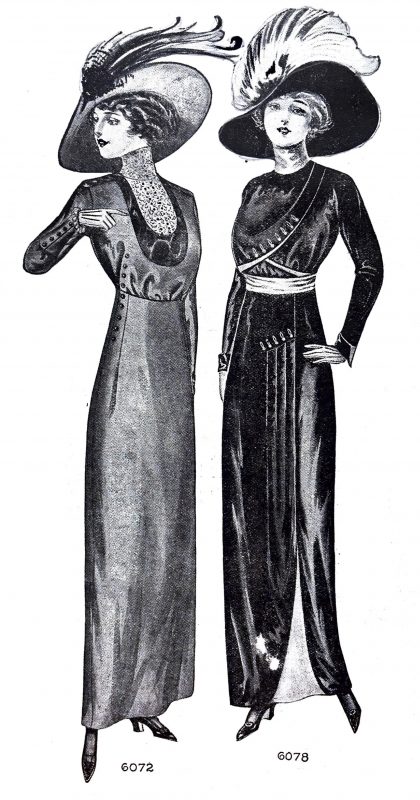
MILADY Is now beginning to turn her mind springward, and to wonder what the now season Is to bring forth. While It Is a little too early to predict definitely Just what will be the Vogue for the coming spring, tho general trend of the fashions Is pretty well established by this time, and we may now have a fairly good Idea of what will be worn during the months to come.
One thing Is assured-the one-piece frock Is to stay, but we will see more of the normal waistline as the season advances, although the -raised effect will still be smart.
For early spring wear a great many silk gowns will be seen, and those of challis, cashmere and albatross will follow closely in the march. We are told that quiet, solid effects will have quite a run, notwithstanding the popularity of fancies.
Regarding the designs, stripes, especially pin- and corded-stripes will be among the most stylish, though ti Is undeniable that checks have gained recently a considerable importance.
It Is Interesting to note that while summer woolens and worsteds are being made in heavier weights than before, the sheer vollellke weaves are getting considerably lighter in weight. This tendency for very filmy goods is considered as one reason for the displacement of wool voiles and marquisettes, by cottons which are manufactured in lighter weights, and are much less expensive.
In fancy voiles, beautiful styles are shown, with warp-stripes produced by cotton or Bilk warp, In chine ribbed or brocaded effects. Among the latest fancy novelties are round velvet stripes. over voile, and also chenille and eponge stripes.
A successful line of fabrics contains voile crepes, with narrow stripes In delicate pastel shades. The popularity of brocaded effects has also extend to brocaded voiles, and many more such styles will be noted as the season advances.
The above-mentioned voile-crepe, and also the voile-crepon, have meet with a decided success both in cotton and wool. The latter are often seen with very narrow silk filling at close intervals, which produces a brilliant pearl-like effect.
Among other popular novelties are the fancy voiles and marquisettes, and also cotton voiles with silk band stripes, corded stripes, and very small window plaids in silk.
The novelties in eoliennes are styled In very small-dotted brocades or Jacquard designs, in ribbed stripes, and other effects. The Jacquard figures are also popular in the eoliennes. The tendency for creped goods is also noticeable here inasmuch as some of the latest styles in eollennes are being shown in crepe-character.
The fancy character of the season has made its influence also In the cotton linings for spring and summer. While cotton-warp satins which are printed and mercerized in the piece are perhaps the staple novelties, combinations woven in two colors, the warp being uniformly black and the filling white, old-gold, bronze, brown, reseda, blue, violet or other fashionable colors are being brought out.
The weave is twill, herringbone, smaller or larger Jacquard figures, serge and weft satin. There are also some smart linings made in changeable-effects, where the black warp is replaced by another color.
Everything bas its touch of fur now, and always there is the corresponding fur-note. The bodice of a gown may boast but a tiny line of ermine, mole or skunk at the top of the collar, but there will be an ermine, mole or skunk muff’ or scarf to match.
Broad scarfs or stoles of mole or seal are very fashionable for wear with the afrernoon-gown, and the broad strip of rich pelt makes a most effective background for the slender lines of the gown.
Buttons figure large In the decorative-scheme, and if one does not fancy actual buttons, there may be button-motifs made of braid, or of bits of oriental embroidery put on in the button-manner-that is, in a row up and down, or across the costume. Buttons pursue every possible way now, and one is quite as likely to find them dashing diagonally down a shoulder, as lining up trimly along the front or a coat.
A delightful reception-dress seen recently had button-motifs of gold, black and crimson on a Russian tunic of Copenhagen-blue broadcloth. The tunic fastened across toward the left, and was edged down the opening with a two-inch band or gray chinchilla-squirrel, which deepened to a six-inch band at the foot of the tunic-just above the knee.
The tunic was finished around the neck with a black corded piping, below which were embroidered splashes all around, done in red and black, and down the front within the fur edge went oblong motifs of gold, black and scarlet embroidery, three motifs close together in three groups, one group close to the belt, above the waistline; another group a few Inches below the belt, and the third group near the wide band of fur.
The belt was of black velvet with a flat bow at one end of the front. A muff of chinchilla-squirrel was carried with this blue dress, and the hat was a diminutive affair of Copenhagen-blue velvet, with a gray feather curling over one side.
Speaking of hats reminds one that tho first showing of spring hats bas revealed several innovations in headwear. Everything for spring in the millinery line is to be low, soft and graceful. Flat, moderately large hats or an exceeding softness of outline are in style.
This season the size or the hat is no longer the feature that presents itself most to the attention, for hat-sizes are moderate, and shapes conform pleasingly to the head, and to the line or the shoulders, this last being a point which the graceful milliner never overlooks, grace, not size, is now the important consideration, and next comes harmony or color.
The varied tones or taupe and smoke-gray, seal-brown and black seen in the early winter bats are to be preserved in those for early spring. Blues, greens and a few strong, though not bright tones or red are seen, these lines appearing rather in the form of telling trimming-touches than in the material of the hat.
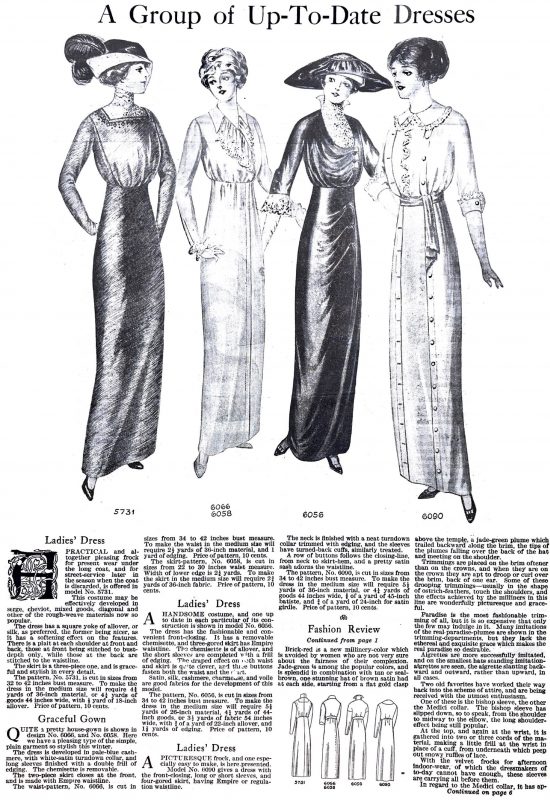
Brick-red is a new millinery-color which is avoided by women who are not very sure about the fairness of their complexion. Jade-green is among the popular colors, and is splendid in combination with tan or seal-brown, one stunning hat of brown satin had at each side, starting from a flat gold-clasp above the temple, a jade-green plume which trailed backward along the brim, the tips of the plumes falling over the back of the hat and meeting on the shoulder.
Trimmings are placed on the brim oftener than on the crowns, and when they are on the crown they are on the crown they are apt to droop or curl over the brim, back of one ear. Some of these drooping trimmings– usually in the shape of ostrich-feathers, touch the shoulders, and the effects achieved by the milliners in this line are wonderfully picturesque and graceful.
Paradise is the most fashionable trimming of all, but it is so expensive that only the few may indulge in it. Many imitations of the real-paradise-plumes are show in the trimming-departments, but they lack the ethereal and exquisite grace which makes the real paradise so desirable.
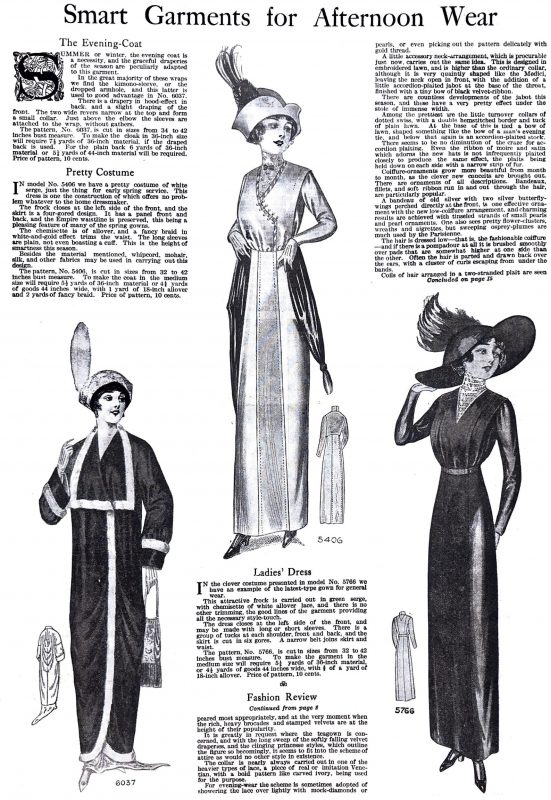
Aigrettes are more successfully imitated, and on the smallest hats standing imitation aigrettes are seen, the aigrette slanting backward and outward, rather than upward, in all cases.
Two old favorites have worked their way back into the scheme of attire, and are being received with the utmost enthusiasm.
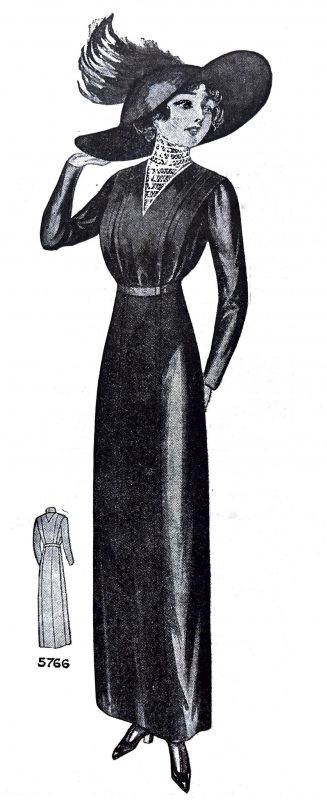
One of these is the bishop sleeve, the other is the Medici collar. The bishop sleeve has slipped down, so to speak, from the shoulder to midway to the elbow, the long shoulder effect being still popular.
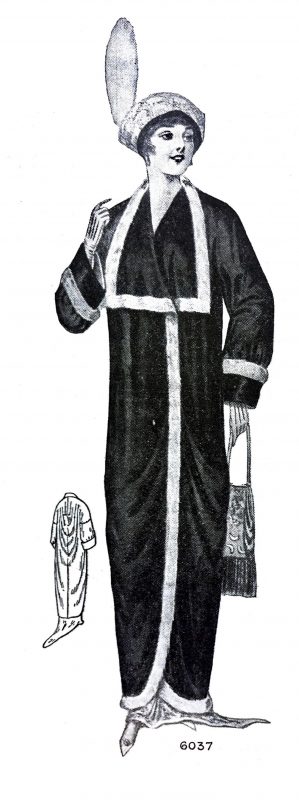
At the top, and again at the wrist, it is gathered into two or three cords of the material, making a little frill at the wrist in place of a cuff, from underneath which peep out snowy ruffles of lace.
In regard to the medici collar, it has appeared most appropriately, and at the very moment when the rich, most heavy brocades and and stamped velvets are at the height of their popularity.
It is greatly in request, where the teagown is concerned, and with the long sweep of the softly falling velvet draperies, and the clinging princesse styles, which outline the figure so becomingly, it seems to fit into the scheme of attire as would no other style in existence.
The collar is nearly always carried out in one of the heavier types of lace, a piece of real or imitation Venetian, with a bold pattern like carved ivory being used for the purpose.
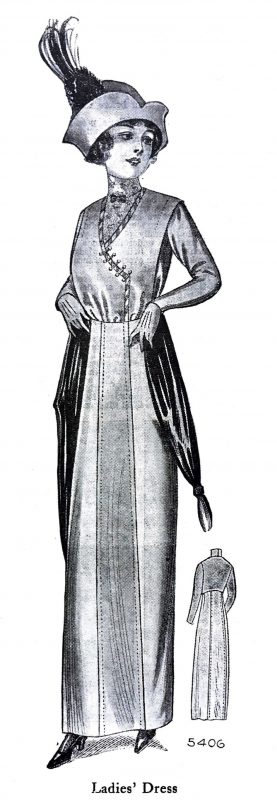
For evening-wear the scheme is sometimes adopted of showering the lace over lightly with mock-diamonds or
(missing text)
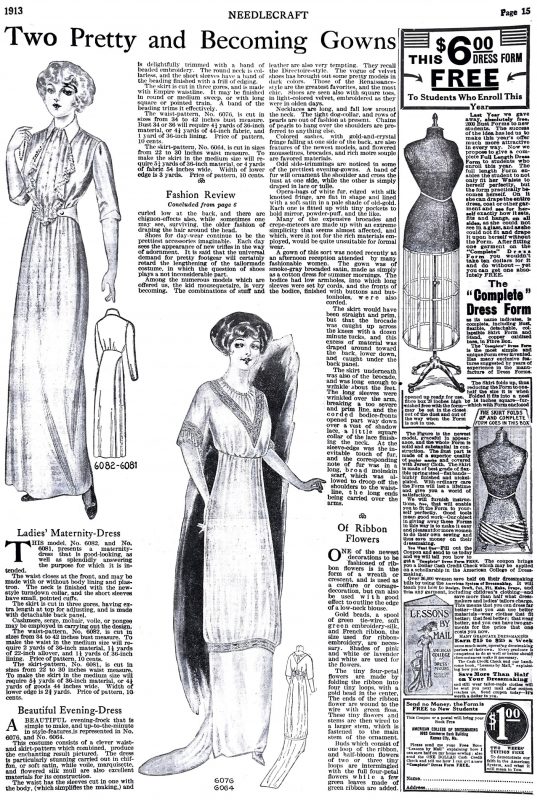
curled low at the back, and there are chignon-effects, also, while sometimes one may see, surviving, the older fashion of draping the hair around the head.
Shoes for day-wear continue to be the prettiest accessories imaginable. Each day sees the appearance of new trifles in the way of adornment. It is said that the universal demand for pretty footgear will certainly retard the lengthening of the tailormade costume, in which the question of shoes plays a not inconsiderate part.
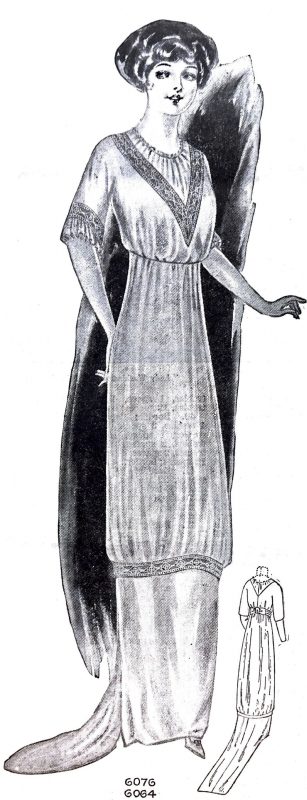
Among the numerous models which are offered us, the kid mousequetaire, is very becoming. The combinations of stuff and leather are also very tempting. The recall the Directoire-style. The vogue of velvet shoes has brought out some pretty models in dark colors. Those of the Renaissance-style are the greatest favorites, and the most chic. Shoes are seen also with square toes, in light-colored velvet, embroidered as they were in olden days.

Necklaces are long, and fall low around the neck. The tight dog-collar, and rows of pearls are out of fashion at present. Chains of pearls to hang over the shoulders are preferred to anything else.
Colored sashes, with gold-and-crystal fringe falling on one side of the back, are also features of the newest models, and flowered mousselines, brocades, and rich moire souple are favored materials.
Odd side-trimmings are noticed in some of the prettiest evening gowns. A band of fur will ornament the shoulder and cross the bust at one side, while the other is simply draped in lace or tulle.
Opera-bags of white fur, edged with silk knotted fringe, are flat in shape and lined with a soft satin in a pale shade of old-gold. Each one is fitted up with a tiny pocket to hold mirror, powder puff, and the like.
Many of the expensive brocades and crepe-meteors are made up with an extreme simplicity that seems almost affected, and which, were it not for the rich materials employed, would be quite unsuitable for formal wear.
A gown of this sort was noted recently at an afternoon reception attended by many fashionable women. The gown was of smoke-gray brocaded satin, made as simply as a cotton dress for summer mornings. The bodice had low armholes, into which the sleeves were set by cords, and the fronts of the bodice, finished with buttons and buttonholes, were also corded.
The skirt would have been straight and prim, but that the brocade was caught up across the knees with a dozen minute tucks, and this excess of material was draped around toward the back, lower down, and caught under the back panel.
The skirt underneath was also of the brocade, and was long enough to wrinkle about the feet. The long sleeves were wrinkled over the arm, breaking a too severe and prim line, and the corded bodice-fronts opened part way down over a vest of shadow lace, a little square collar of the lace finishing the neck. At the sleeve-edge was the inevitable touch of fur, and the corresponding note of fur was in a long, broad moleskin scarf, which was allowed to droop off the shoulders to the waistline, the long ends being carried over the arms.
Of Ribbon Flowers
ONE of the to newest decorations to be fashioned of ribbon flowers is in the form of a wreath or crescent, and is used as a coiffure or corsage-decoration, but can also be used with good effect to outline the edge of a low-neck blouse.
Gold beads, a spool of green tie-wire, soft green embroidery-silk, and French ribbon, the size used for ribbon embroidery, are necessary. Shades of pink and white or lavender and white are used for the flowers.
The tiny four-petal flowers are made by folding the ribbon into four tiny loops, with a gold bead in the center. The ends of the ribbon flower are wound to the wire with green floss. These tiny flowers and stems are then wired to a larger stem, which is fastened to the main stem of the ornament.
Buds which consist of one loop of the ribbon, and half-bloom flowers of two or three tiny loops are intermingled with the full four-petal flowers while a few green leaves made of green ribbon are added.
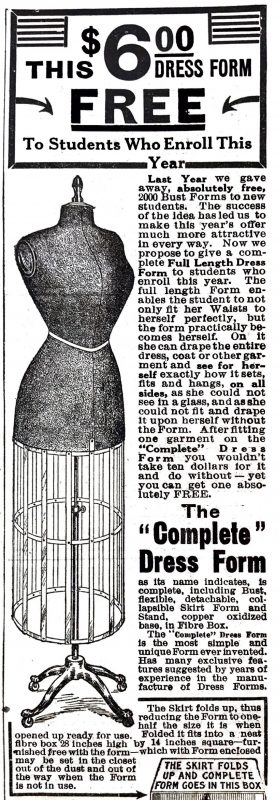
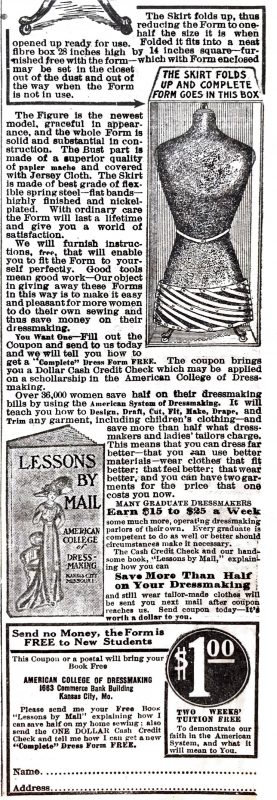

Mary
February 8, 2021 at 12:16 pm (5 years ago)those ‘up-to-date dresses’ are trending now with less length – I’d make one of them in a minute
PepperReed
February 10, 2021 at 2:00 pm (5 years ago)Love 6056 from ‘ A Group of Up-To-Date Dresses’. That collar and draping is wonderful!
Nancy
February 23, 2021 at 5:20 pm (5 years ago)These are wonderful